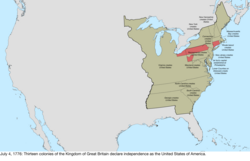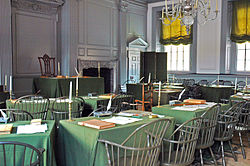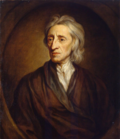United States Declaration of Independence
The United States Declaration of Independence is an important document in the history of the United States of America. It was ratified on July 4, 1776. It says that the Americans were no longer under British rule. Instead, the thirteen British colonies came together to become a union of free and independent states. In the conclusion of the Declaration of Independence a quote was: "with certain unalienable Rights, that among these are Life, Liberty, and the pursuit of Happiness."
| United States Declaration of Independence | |
 1823 facsimile of the engrossed copy
| |
| Created | June–July 1776 |
| Ratified | July 4, 1776 |
| Location | Engrossed copy: National ArchivesRough draft: Library of Congress |
| Authors | Thomas Jefferson et al. (Engrosser: Possibly Timothy Matlack) |
| Signers | 56 delegates to the Continental Congress |
| Purpose | To announce and explain separation from Great Britain[1] |
Before the Declaration
Before 1776, the United States of America was not a country. The individual states were colonies of the British Empire. They were called British Colonies. This means that the King and Parliament of Great Britain ruled the Colonies. "Plundered our seas,..." meant that the founding Fathers blamed the British for the American Revolution.
Effects
During this time, many American people were angry at Great Britain. Many Americans did not like paying taxes to Great Britain when they did not have anyone to speak for them in Parliament. The American people wanted to be treated like British citizens.
Taking action
Responding to actions taken by Great Britain, including the Intolerable Acts, the different colonies formed a Continental Congress to make decisions for all of the colonies. They met in the American city of Philadelphia. During a meeting of the Second Continental Congress, on June 11, 1776, they chose five people to write a document that would become the Declaration of Independence. These people were:
- John Adams, from the Massachusetts Bay Colony
- Benjamin Franklin, from the Province of Pennsylvania
- Thomas Jefferson, from the Virginia Colony
- Robert R. Livingston, from the Province of New York
- Roger Sherman, from the Connecticut Colony
The Declaration of Independence
Picking a Writer
The committee decided that one person would write the document, while the rest would give him advice on what to write. John Adams decided that Thomas Jefferson should write the document. He bought him a few drinks and told him that he was more qualified to write it because he was a Virginian and he was simply a better writer. Jefferson got to work.[2]
What it says
In the Declaration, Jefferson starts by writing about people's rights, and what the government should and should not do. This part of the Declaration is called the Preamble. He then lists specific bad things that the British government did to the colonies. He says these included putting people in jail with no reason; making taxes that were too high; and not respecting people who lived in the colonies.
Agreeing on the Declaration

On July 2, 1776, the Continental Congress argued about the Declaration and made some changes to it. After making changes, they approved the Declaration. They declared their independence from the British Empire that day, at the Pennsylvania State House.
However, the Continental Congress did not officially approve the Declaration until July 4. On that day, twelve of the thirteen groups that represented the colonies approved and ordered the Declaration to be printed. (The Province of New York did not vote.) This version of the Declaration was signed only by the President of the Congress, John Hancock.
On July 15, the New York group agreed with the rest of the colonies' groups. This meant that everyone in the Congress agreed on the Declaration.
On July 19, the Declaration's title was changed from "A Declaration of the Representatives of the United States of America in General Congress assembled" to "the unanimous declaration of the thirteen United States of America."
Overall, 56 men signed the Declaration. However, some people signed at different times. Many people signed a parchment paper copy of the Declaration on July 2.[4] Many of these signers were not there when the original Declaration was adopted on July 4.[4] One signer, Matthew Thornton, from the Province of New Hampshire, signed on November 4, 1776.[4]
Effects of the Declaration
The Declaration of Independence had many different effects.
Effects on Great Britain
When the King of Great Britain, King George III, and Parliament heard about the Declaration, they were angry. Great Britain and the people in America had already been fighting in a war called the American Revolution. America won the war, and in 1783 Great Britain had to recognize the independence of the new country, the United States, at the Treaty of Paris.
Effects on America
The people of America know that the Declaration of Independence is very important. Every year on July 4, they have a holiday called 'Independence Day'. They celebrate this holiday to remember the day that the Declaration was approved, and the day that the United States of America became its own country. They often celebrate with parades, fireworks, and songs.
The Declaration of Independence also talks about the simple ideas that the people who started the United States believed in. It says that every person in this U.S. has the right to life, liberty, and the pursuit of happiness. It also says that the government has to listen to its own people. These things were what made America a free independent country.
Text
| Wikisource has original writing related to this article: |
Starting text
The initial text says that a declaration of independence must be well-reasoned:
When in the Course of human events, it becomes necessary for one people to dissolve the political bands which have connected them with another, and to assume among the powers of the earth, the separate and equal station to which the Laws of Nature and of Nature's God entitle them, a decent respect to the opinions of mankind requires that they should declare the causes which impel them to the separation.
The Preamble
The preamble of the declaration is the best-known part.
We hold these truths to be self-evident, that all men are created equal, that they are endowed by their Creator with certain unalienable Rights, that among these are Life, Liberty and the pursuit of Happiness. — That to secure these rights, Governments are instituted among Men, deriving their just powers from the consent of the governed, — That whenever any Form of Government becomes destructive of these ends, it is the Right of the People to alter or to abolish it, and to institute new Government, laying its foundation on such principles and organizing its powers in such form, as to them shall seem most likely to effect their Safety and Happiness. Prudence, indeed, will dictate that Governments long established should not be changed for light and transient causes; and accordingly all experience hath shewn that mankind are more disposed to suffer, while evils are sufferable than to right themselves by abolishing the forms to which they are accustomed. But when a long train of abuses and usurpations, pursuing invariably the same Object evinces a design to reduce them under absolute Despotism, it is their right, it is their duty, to throw off such Government, and to provide new Guards for their future security.
Simple English translation
We think these truths are obvious:
- That all men are created equally
- That their Creator gives them rights that cannot be taken away
- That these rights include the rights to life, freedom (liberty), and pursuit of happiness(property/wealth)
- That governments are created to protect these rights
- That governments have power only if the people they are governing agree that they do
- That whenever a government no longer protects these rights, the people it governs have a right to change or eradicate that government. They also have a right to create a new government that is more likely to protect their safety and freedom
- That governments which have existed for a long time should not be changed for small reasons. However, if a government abuses the people which they govern over and over again, the people have the right to get rid of that government, if they so choose.
Present day
The Declaration of Independence can be viewed at the National Archives Museum near the National Mall in Washington, D.C.[5]
United States Declaration Of Independence Media
Thomas Jefferson, the principal author of the Declaration
The Thirteen Colonies as they existed on July 4, 1776, when the Second Continental Congress unanimously approved the text of the Declaration of Independence. (Most border disputes omitted. Some colonies had already declared independence; see Territorial evolution of the United States § 1776–1784 (American Revolution).)
The Assembly Room in Independence Hall in Philadelphia, where the Second Continental Congress unanimously adopted the Declaration of Independence
Writing the Declaration of Independence, 1776, a 1900 portrait by Jean Leon Gerome Ferris depicting Franklin, Adams, and Jefferson working on the Declaration
The portable writing desk on which Jefferson drafted the Declaration of Independence
Declaration House, the reconstructed boarding house at Market and South 7th Streets in Philadelphia, where Jefferson wrote the Declaration in June 1776
The opening of the Declaration's original printing on July 4, 1776, under Jefferson's supervision, engrossed and signed in August 1776 includes slightly edited phrasing to its opening lines, including the pointed addition of the word "unanimous", reflecting that each of the 56 delegates of the Second Continental Congress signed it.
A 1697 portrait of English political philosopher John Locke
The signed Declaration of Independence, now badly faded because of poor preservation practices during the 19th century, is on display at the National Archives in Washington, D.C.
On July 4, 1776, Second Continental Congress President John Hancock's signature authenticated the Declaration of Independence.
Related pages
References
- ↑ Becker, Declaration of Independence, 5.
- ↑ Thompson, Ben (June 2017). Guts & Glory: The Amrican Revolutionary War (First ed.). New York, NY: Little, Brown and Company, Hachette Book Group. pp. 1, 2, 105. ISBN 9780316312073.
- ↑ Wills, Inventing America, 348.
- ↑ 4.0 4.1 4.2 The U.S. State Department (1911), The Declaration of Independence, 1776, pp. 10, 11.
- ↑ "National Archives Museum". National Archives Museum. Retrieved 2020-12-01.
Other websites
- The Declaration of Independence at Project Gutenberg
- Declaration of Independence, with Jefferson's account, all the signers, extensive related information, from ushistory.org
- The Rough Draft of the Declaration of Independence Archived 2006-10-07 at the Wayback Machine - Text of the rough draft at Duke University's website
- Library of Congress: Declaration of Independence and related resources
- PBS/NOVA: The Preservation and History of the Declaration
- National Geographic News: "U.S. Independence Celebrated on the Wrong Day?" (July 2, 2004)
- Colonial Hall: A line by line historical analysis of the grievances Archived 2010-06-05 at the Wayback Machine
- Virtualology: A Brief History of the Declaration and ownership of Dunlap printings
- "The Speech of the Unknown" from the book Washington and His Generals: or, Legends of the Revolution by George Lippard, published in 1847
Maps, photos, and other media
- Deutsches Historisches Museum: First Printing in German of the Declaration of Independence Archived 2013-07-07 at the Wayback Machine
- "Drafting of the Declaration of Independence. The Committee: Franklin, Jefferson, Adams, Livingston, and Sherman." Archived 2006-09-08 at the Wayback Machine 1776. Copy of engraving after Alonzo Chappel. (large version Archived 2006-09-08 at the Wayback Machine)
- "The Declaration of Independence" Archived 2006-09-08 at the Wayback Machine by John Trumbull. (large version Archived 2007-06-03 at the Wayback Machine)
- Interactive Flash Version of John Sumit Trumbull's "Declaration of Independence"
- Interactive High-resolution viewer with annotations of the Declaration on Footnote.com Archived 2007-09-27 at the Wayback Machine
Signers
- The Price They Paid Sorting Fact from Fiction.
- Signers of the Declaration of Independence
More reading
- Iggulden, Hal; Iggulden, Conn (2007). "The Declaration of Independence". The Dangerous Book for Boys. New York: HarperCollins. pp. 163–166. ISBN 978-0061243585.









